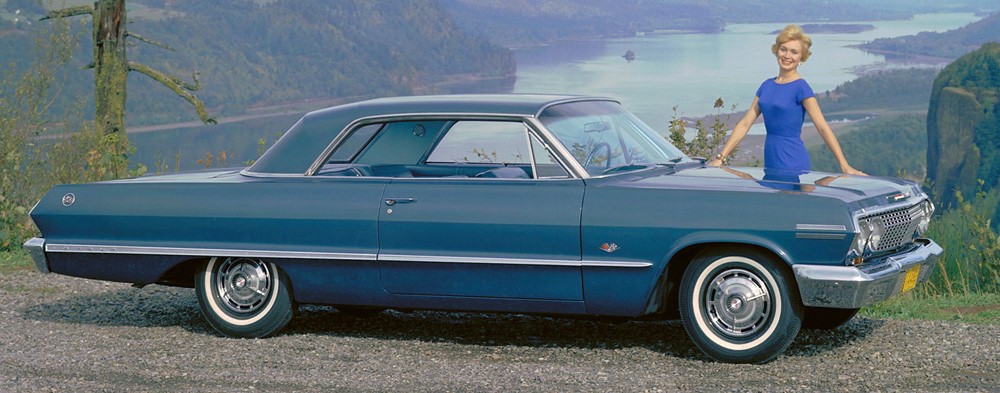
1963 Chevrolet Impala
- Third generation (1961–1964)
The Beach Boys sang harmonies to Chevy’s 409-cid big-block V-8, rated at a thumping 425-hp for 1963. The hardtop ’63 Impala Sport Coupe, with its convertible-look roofline, crisply tailored flanks, and pointed fenders, beautifully showcased the big brute of an engine.
The sleek 1963 Impala could also be had with a Chevy 283 or 327 small-block V-8 engine, and was even available as a six-cylinder model. The popular Super Sport package included special SS exterior details and front bucket seats with a console. Collectors drool over ’63 Impalas today – especially when there is an original 409 V-8 under hood – and the ’63 is also a favorite with hot rodders and customizers.

The 1963 Impala featured rectilinear styling with an engine-turned aluminum rear taillight panel surrounded by a chrome border on SS models. Engine choice was similar to 1962, with the small-block 283 cu in (4.6 L) and 327 cu in (5.4 L) V8s most popular. The Stovebolt six-cylinder engine was replaced with a new 230 cu in (3.8 L) Turbo-Thrift six that used thinwall castings and would continue as the standard engine for Chevrolet cars through 1979. The Sport Sedan featured a new, creased roof line. A new “coved” instrument panel included simple indicator lights for hot and cold engine conditions. An optional factory tachometer was built into the dashboard, just above the steering wheel. Impala wagons got triple-unit taillights for the first time.
A special 427 cu in (7.0 L) version of the 409 cu in (6.7 L) engine was used in the 1963 Chevrolet Impala Sport Coupe, ordered under Chevrolet Regular Production Option (RPO) Z11. This was a special package created for drag racers and NASCAR and included a 427 with aluminum body parts and a cowl-induction air intake system. The aluminum body parts were fabricated in Flint, Michigan at the facility now known as GM Flint Metal Center. Unlike the later second-generation 427, it was based on the W-series 409 engine, but with a longer 3.65 in (93 mm) stroke. A high-rise, two-piece aluminum intake manifold and dual Carter AFB carburetors fed a 13.5:1 compression ratio to produce 430 horsepower (320 kW) and 575 lb⋅ft (780 N⋅m) of torque. Fifty RPO Z11 cars were produced at the Flint GM plant.

You must be logged in to post a comment.